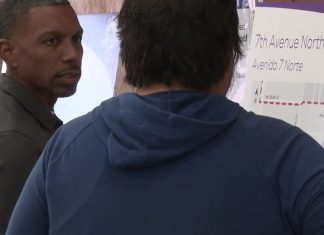Six months away from its 250th year, the United States of America is still in its infancy. It is an empire forever moving and shifting, trying to decide what it will be. Prolific documentarian Ken Burns and his co-directors, Sarah Botstein and David Schmidt, bring America’s bloody origin story to life in PBS’ vast, highly detailed “The American Revolution,” a project that took nearly a decade to bring to the small screen. Spanning three decades and two continents, the six-episode, 12-hour docuseries is a treasure trove of oft-forgotten history, illustrating who we were and illuminating who we are as a country.
Narrated by frequent Burns collaborator Peter Coyote, “The American Revolution” starts well before that fateful July day in 1776 when the Second Continental Congress formally adopted the Declaration of Independence. The directors begin the tale almost 20 years earlier, when Benjamin Franklin first publicly called for the British colonies to form a union. Franklin’s proposal was initially rejected, yet, as the series highlights, the events of the subsequent years — including unfair taxation by the British government, the French and Indian War, the Boston Massacre and later the Boston Tea Party — led the colonists, who called themselves Patriots, to revisit Franklin’s plan.
As with many of Burns’ works, like “The Civil War,” “The American Buffalo” and even “Jazz,” “The American Revolution” is as intricate as it is dense. In the absence of photographs and other modern visuals, the crew used several techniques to bring the period and the hard-won battles to life. Using animated maps and portraits, voice-overs by distinguished orators including Keith David, Tom Hanks, Meryl Streep and Samuel L. Jackson and commentary from such historians and scholars as Vincent Brown and Maggie Blackhawk, the filmmakers and writer Geoffrey Ward create a multidimensional tapestry of the era. Moreover, in hearing firsthand accounts from loyalists and the English Crown, enslaved and free Blacks, Indigenous people, women and patriot fighters across the 13 colonies, the series conveys how diverse America has always been and how this war affected everyone.
“The American Revolution” goes deep, almost tediously so. It’s also stuffed with riveting sequences, betrayals and shocking turns of events. Episode 3, “The Times That Try Men’s Souls (July 1776-January 1777)” is particularly compelling. The episode mostly centers on early battles, including the Battle of Trenton, a decisive American victory that boosted morale within the fledgling Continental Army. Audiences are immersed in the horrors of the war, which was fought eyeball to eyeball by landless men wielding muskets, unreliable rifles and terrifying bayonets. George Washington, who commanded the Americans, often made costly mistakes, and soldiers frequently went months without pay or proper food and clothing — even as they were exposed to the elements or the deadly smallpox. (Washington would later demand that all soldiers be inoculated in an early version of a vaccination mandate.)
In true Burns fashion, “The American Revolution” is exhaustively thorough, leaving no popular figure or person on the fringes overlooked. By portraying the war not simply from the American point of view but from a global perspective, “The American Revolution” presents a rounded picture of this country at its foundation. It was an idea that eventually became a reality. The series also highlights the cracks in our ongoing union and suggests how we might overcome our fallacies as a nation so that it might endure and truly become the place of liberty that it was intended to be. For now, however, the American Revolution continues.
“The American Buffalo” premieres on PBS Nov. 16, with remaining episodes airing each consecutive night.







